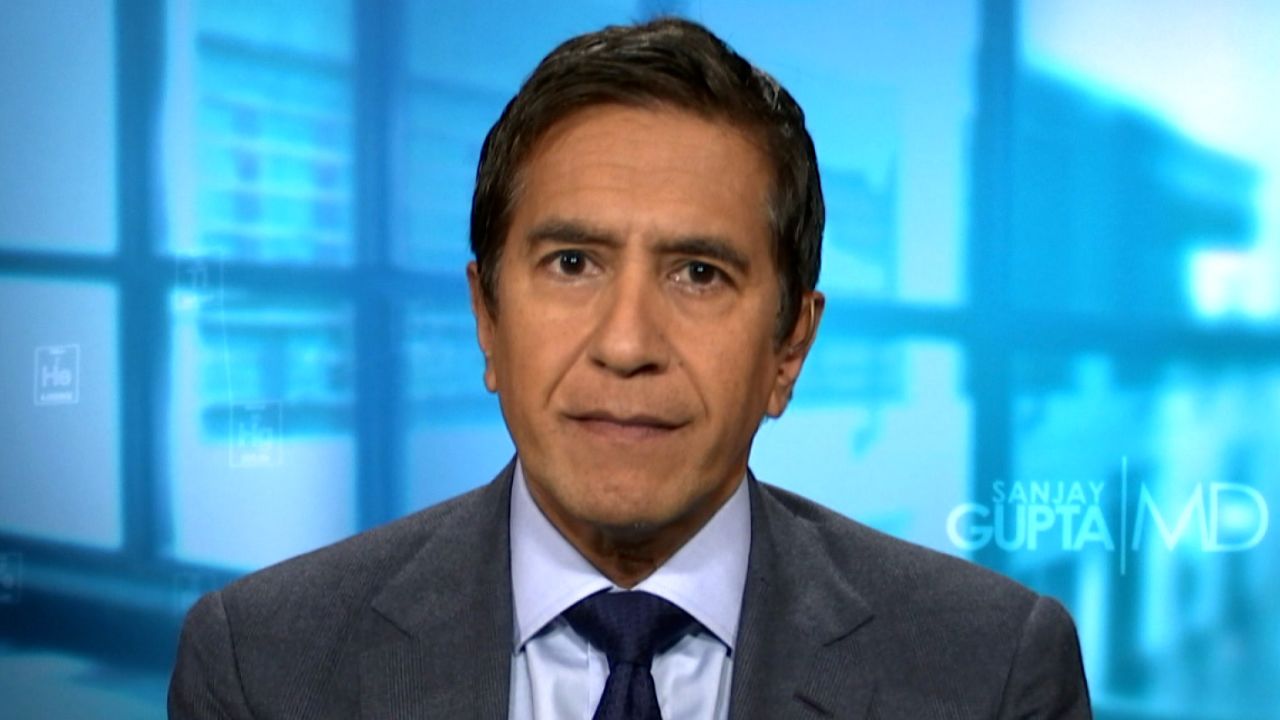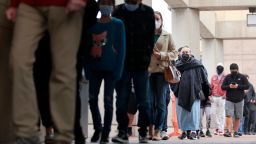This moment in time, like so many during the last two-plus years of the pandemic, is a confusing one for our country. Mixed signals make it hard to accurately gauge risk and act accordingly.
On the one hand, with the almost complete lifting of restrictions and mandates around the country, and with case numbers, hospitalizations and deaths at relatively low levels, it’s easy to feel that life is on track to getting back to normal, if not already there.
That’s especially true when someone as cautious as President Joe Biden’s chief medical officer, Dr. Anthony Fauci, says that we are out of the pandemic phase, as he did a couple of weeks ago on PBS NewsHour.
“Namely, we don’t have 900,000 new infections a day and tens and tens and tens of thousands of hospitalizations and thousands of deaths. We are at a low level right now. So, if you’re saying, Are we out of the pandemic phase in this country? We are,” he said.

But hundreds are still dying every day. The United States is marking the tragic milestone of 1 million confirmed Covid-19 deaths. In a statement on Thursday, Biden urged the United States to “remain vigilant against this pandemic and do everything we can to save as many lives as possible.”
Covid-19 cases have been trending up in almost every state; the country is now averaging more than 70,000 new cases per day, according to Johns Hopkins University. Pediatric cases are on the rise too – up 69% from two weeks ago, according to the American Academy of Pediatrics.
Even hospitalizations, a lagging indicator, have been increasing slowly: They’re up in more than half of states (including most of the Northeast and Midwest) compared with last week and as of Thursday morning stand at more than 20,000 – levels last seen at the end of March.
The White House is warning that if Congress doesn’t provide additional resources for testing, treatments and vaccines, the country will be ill-prepared for a surge this fall or winter, when it says the country could see 100 million new Covid-19 infections. That’s just one possibility for the seasons ahead, and the White House hasn’t released specific modeling to support that number. But if it happens, that’s almost a third of the entire US population. For context, seasonal flu causes illness in 9 to 41 million Americans – that’s 3% to 11% of the population – every year, according to the US Centers for Disease Control and Prevention.
And even Fauci felt the need to clarify his earlier remarks. “We’re not over the pandemic. Don’t let anybody get the misinterpretation that the pandemic is over, but what we are in is a different phase of the pandemic,” he said in a telephone interview with CNN a few days after his original comments.
“A phase that’s a transition phase, hopefully headed toward more of a control where you can actually get back to some form of normality without total disruption of society, economically, socially, school-wise, et cetera,” he said.
So which is it: Are we headed back to life as usual or are we headed toward another wave of infections?
Absolute numbers vs. trendlines
I want to return to the analogy of the country as my patient, as I have done several times during the pandemic.
If I had to describe the current situation, I’d say it’s like my patient has checked out of the hospital – a bit weak, still being monitored carefully and receiving outpatient care.
And now, as the rising case numbers indicate, they’ve spiked a fever, developed a sore throat and are starting to feel all-around miserable.
The big question is, will they get better with time, or is this a harbinger of more bad things to come?
While it’s true that the numbers are nowhere near as dire as they were with the Delta or original Omicron surges – which saw an average of more than 166,000 and more than 807,000 daily new cases at their respective peaks – these insidious increases in cases and hospitalizations reveal a trendline. In medicine, trendlines are often more telling than the absolute numbers themselves: They’re important to spot because they show us where the patient is headed. And right now, the trendline is moving in a risky direction.
So it seems that we’re now in a watchful waiting phase with my patient to see what happens next.
The patient in the next bed
Another way to predict which way my patient may be headed is to look at another patient with the same malady, but who is a little further along in their disease course. In this case, we can look to South Africa.
The news isn’t exactly encouraging: Recently, the health minister cautioned that the country may be entering its fifth Covid-19 wave.
“We’ve been expecting… that probably middle of May… or even early in June, we may enter the fifth wave [of Covid-19],” Joe Phaahla said during an April 29th news conference. The wave is being driven by two new Omicron subvariants, BA.4 and BA.5; its unclear whether the illness caused by these new subvariants is more or less severe than earlier ones.
Former White House Coronavirus Task Force coordinator Dr. Deborah Birx, who has been carefully tracking the situation in South Africa, foresees my patient’s health following a similar trajectory.
“I know that another surge is coming and will be coming across the world,” Birx said during a Washington Post Live discussion at the end of April. That’s because, Birx said, approximately 50 to 60% of the South African population is infected during each surge fueled by a new variant – a pattern that repeats itself every four to six months. Birx said this shows “there’s no protection, and there’s no long-lived natural immunity.”
To be sure, infection-acquired immunity can be very protective, but with SARS-CoV-2, there is so much difference between variants that a recent infection with one variant may provide little protection against the next.
My patient, America, is still grappling with Omicron subvariant BA.2, according to the latest variant tracking estimates from the CDC. But a subvariant of BA.2 – called BA.2.12.1 – is quickly gaining traction, especially in the Northeast, and now makes up just over 40% of cases.
Birx is not the only one who thinks my patient is headed for a bumpy ride.
Dr. Peter Marks, director of the Center for Biologics Evaluation and Research at the US Food and Drug Administration, said on Monday he is “a little concerned” about the direction of the pandemic and predicts a “modest peak” in the next month.
Dr. David Dowdy, an associate professor in the department of epidemiology at Johns Hopkins Bloomberg School of Public Health, thinks my patient already may be surging.
“I think it’s important for us to realize that in some ways, we are already in the midst of a surge,” he said during a news briefing on Tuesday.
“There are indicators that the amount of transmission happening in this country right now, while not the same as it was this past winter, is at the levels that we were seeing during the Delta wave … But what we’re not seeing are the same rise in hospitalizations and deaths – so, we’re seeing a small uptick but not the same tremendous rise that we’ve seen with some of these previous waves.”
It’s all about the immunity
The problem all comes down to waning immunity, both from natural infection and from vaccines, including boosters.
According to data from the CDC released in late April, almost 60% of adults and 75% of children have antibodies indicating that they’ve been infected with SARS-CoV-2. But that doesn’t necessarily translate to protection from the next variant.
And it’s fair to say that waning immunity is also true for vaccines. Estimates show the amount of protection against infection hinges on many factors – including the age and health status of the recipient, the type of vaccine a person received and the variant that’s circulating. But protection fades after a few months.
A CDC task force presented data in late April showing that two doses of the Johnson & Johnson vaccine are only 30% effective against Omicron two to four months after the shots. That number is higher, 63%, with three doses of an mRNA vaccines, either Pfizer/BioNTech or Moderna. But both numbers are lower than the initial protection the vaccines provided.
The good news is that getting re-boosted helps. A new study, also out of the UK and published Monday in The Lancet Infectious Diseases, found that a fourth dose of an mRNA vaccine provided a “substantial” boost to immunity at similar or even better levels than a third dose, when given about seven months after a first booster shot
Of course it’s important to keep in mind, even though vaccines may not protect against infection by new subvariants very well, they are still very good – though not perfect – at greatly lowering the risk of hospitalization and death. These are the outcomes we all want to avoid and what vaccines are designed to do. In fact, the overall risk of dying from Covid-19 is about five times higher for unvaccinated people than it is for those vaccinated with at least their primary series, according to the CDC.
That said, waning effectiveness and higher transmission rates have led to an increase in the share of Covid-19 deaths among vaccinated people. According to CDC data, about 40% of Covid-19 deaths in January and February were among vaccinated people, compared with 25% during the height of the Delta wave in the second half of September.
But only about 15% of deaths in February were among those vaccinated and boosted. As has been the case throughout the pandemic, those age 65 and older face the highest risk.
Another way of looking at the numbers, according to a CNN analysis, is that people vaccinated with only their initial series faced about three times greater risk of dying (after adjusting for age) than those who also got their booster shot.
As for hospitalizations, CDC data from December and January (when Omicron was dominant) show that getting boosted was 90% effective at preventing that outcome, compared to 57% for those who only got the primary series and were six months or more past their last shot.
Doctors’ orders: Get boosted
All of these statistics underscore how critical it is to get boosted.
A senior Biden administration official told CNN Monday that all adults in the United States should get a booster, noting that it’s the best way to protect oneself.
But that’s not happening. According to the CDC, currently in the US, just over 220 million people – 70% of the eligible population (ages 5 and up) – are fully vaccinated, that is, they’ve received their primary series. But only 101.4 million – 46% of the fully vaccinated – have gotten their first booster. And only about 10 million people have received a second booster, which is authorized for people 50 and older, as well as those who are 12 and older and who are immunocompromised.
The senior Biden administration official noted that Covid case numbers are currently highest in the Northeast – states that have a relatively large percentage of the population boosted, which has kept hospitalizations and deaths relatively low – and expressed concern that when cases pick up steam in the South, where the percent of people boosted is much lower, there will be a jump in hospitalization rates and deaths.
The FDA’s Marks agrees boosting is the way to go. “It’s really important that we try to get the Americans who have only received two doses to get that third dose,” he said. “That may make a difference moving forward here, and it may particularly make a difference now that we’re coming into yet another wave of Covid-19.”
Dowdy, from JHU, said getting boosted is especially important for those at greatest risk. “So those whose immune systems are weak, those who are older, to make sure that you’ve been vaccinated, boosted and gotten that second booster or additional shots,” he said.
“We’re starting to see also that the older population and the immunocompromised populations are again accounting for a larger and larger fraction of people in the hospital and people dying. So those boosters are very important,” he added.
Don’t throw caution to the wind
While the country – my patient – is in a watchful waiting phase to see how their illness progresses, there are other small steps we, as individuals, can still take to mitigate risk. And by that I mean following the common sense public health measures we’ve been talking about for the last two years: putting on a high quality mask, especially in crowded indoor spaces; increasing ventilation where possible; and, now more than ever, keeping an eye on the local conditions.
Let me share a personal example. My mom’s 80th birthday was this past weekend, and we decided not to have a big celebration because we’re still not comfortable gathering a bunch of octogenarians together in a room. We gathered as a family – but it was a much smaller group.
Get CNN Health's weekly newsletter
Sign up here to get The Results Are In with Dr. Sanjay Gupta every Tuesday from the CNN Health team.
What struck me was, if my mom (or any of her friends) were to be exposed, the likelihood of being hospitalized or dying is very low because she’s vaccinated and boosted. But as a virologist friend of mine said, it is still likely to be the worst viral illness she has ever had in her life, and she’d be miserable. And who wants to go through that at 80, or at any age?
Plus, there’s always the worry about long Covid, with its long list of lingering and sometimes devastating effects.
As expert after expert has said, we have to accept – my patient has to accept – that Covid-19 is not going away; we’re all going to be living with this virus for a long time. This is our new normal; we will adapt to this as we have adapted to so many of the changes to our daily lives brought by the passage of time.
We have the tools to survive; it’s up to each of us to decide if and how to use them.
CNN Health’s Andrea Kane contributed to this report.


























